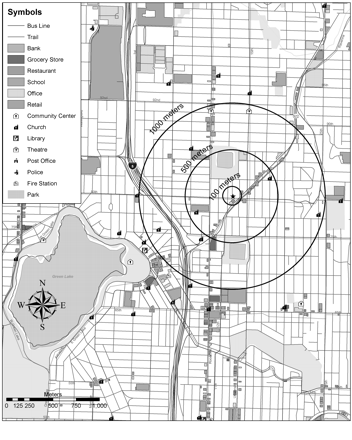Association of the built environment with physical activity and obesity in older persons
- PMID: 17267713
- PMCID: PMC1805010
- DOI: 10.2105/AJPH.2006.085837
Association of the built environment with physical activity and obesity in older persons
Abstract
Objective: We examined whether older persons who live in areas that are conducive to walking are more active or less obese than those living in areas where walking is more difficult.
Methods: We used data from the Adult Changes in Thought cohort study for a cross-sectional analysis of 936 participants aged 65 to 97 years. The Walkable and Bikable Communities Project previously formulated a walkability score to predict the probability of walking in King County, Washington. Data from the cohort study were linked to the walkability score at the participant level using a geographic information system. Analyses tested for associations between walkability score and activity and body mass index.
Results: Higher walkability scores were associated with significantly more walking for exercise across buffers (circular zones around each respondent's home) of varying radii (for men, odds ratio [OR]=5.86; 95% confidence interval [CI]=1.01, 34.17 to OR=9.14; CI=1.23, 68.11; for women, OR=1.63; CI=0.94, 2.83 to OR=1.77; CI=1.03, 3.04). A trend toward lower body mass index in men living in more walkable neighborhoods did not reach statistical significance.
Conclusions: Findings suggest that neighborhood characteristics are associated with the frequency of walking for physical activity in older people. Whether frequency of walking reduces obesity prevalence is less clear.
Figures


Similar articles
-
Protective association between neighborhood walkability and depression in older men.J Am Geriatr Soc. 2007 Apr;55(4):526-33. doi: 10.1111/j.1532-5415.2007.01108.x. J Am Geriatr Soc. 2007. PMID: 17397430
-
Association of Neighborhood Walkability With Change in Overweight, Obesity, and Diabetes.JAMA. 2016 May 24-31;315(20):2211-20. doi: 10.1001/jama.2016.5898. JAMA. 2016. PMID: 27218630
-
Correlates of non-concordance between perceived and objective measures of walkability.Ann Behav Med. 2009 Apr;37(2):228-38. doi: 10.1007/s12160-009-9098-3. Epub 2009 Apr 25. Ann Behav Med. 2009. PMID: 19396503
-
Examining the relationships between walkability and physical activity among older persons: what about stairs?BMC Public Health. 2018 Aug 17;18(1):1025. doi: 10.1186/s12889-018-5945-0. BMC Public Health. 2018. PMID: 30119657 Free PMC article. Review.
-
Walkability indices and childhood obesity: A review of epidemiologic evidence.Obes Rev. 2021 Feb;22 Suppl 1(Suppl 1):e13096. doi: 10.1111/obr.13096. Epub 2020 Jul 27. Obes Rev. 2021. PMID: 33185012 Free PMC article. Review.
Cited by
-
Relationships between the built environment and walking and weight status among older women in three U.S. States.J Aging Phys Act. 2014 Jan;22(1):114-25. doi: 10.1123/japa.2012-0137. Epub 2013 Mar 26. J Aging Phys Act. 2014. PMID: 23538637 Free PMC article.
-
The Role of Built Environment on Health of Older Adults in Korea: Obesity and Gender Differences.Int J Environ Res Public Health. 2019 Sep 19;16(18):3486. doi: 10.3390/ijerph16183486. Int J Environ Res Public Health. 2019. PMID: 31546780 Free PMC article.
-
Obesity, Hypertension, and Type-2 Diabetes Mellitus: The Interrelationships and the Determinants among Adults in Gaza City, Palestine.Osong Public Health Res Perspect. 2018 Dec;9(6):289-298. doi: 10.24171/j.phrp.2018.9.6.02. Osong Public Health Res Perspect. 2018. PMID: 30584492 Free PMC article.
-
The influence of neighborhood residential density, physical and social environments on older adults' physical activity: An exploratory study in two metropolitan areas.J Aging Stud. 2012 Jan;26(1):35-43. doi: 10.1016/j.jaging.2011.07.001. Epub 2011 Aug 17. J Aging Stud. 2012. PMID: 37841338 Free PMC article.
-
Resident Perceptions of Neighborhood Conditions, Food Access, Transportation Usage, and Obesity in a Rapidly Changing Central City.Int J Environ Res Public Health. 2018 Jun 7;15(6):1201. doi: 10.3390/ijerph15061201. Int J Environ Res Public Health. 2018. PMID: 29880764 Free PMC article.
References
-
- Mokdad AH, Bowman BA, Ford ES, Vinicor F, Marks JS, Koplan JP. The continuing epidemics of obesity and diabetes in the United States. JAMA. 2001; 286:1195–1200. - PubMed
-
- Haslam DW, James WP. Obesity. Lancet. 2005; 366:1197–1209. - PubMed
-
- Flegal KM, Carroll MD, Ogden CL, Johnson CL. Prevalence and trends in obesity among U.S. adults, 1999–2000. JAMA. 2002;288:1723–1727. - PubMed
-
- Arterburn DE, Crane PK, Sullivan SD. The coming epidemic of obesity in elderly Americans. J Am Geriatr Soc. 2004;52:1907–1912. - PubMed
-
- Marchesini G, Melchionda N, Apolone G, et al. The metabolic syndrome in treatment-seeking obese persons. Metabolism. 2004;53:435–440. - PubMed
Publication types
MeSH terms
Grants and funding
LinkOut - more resources
Full Text Sources
Medical

